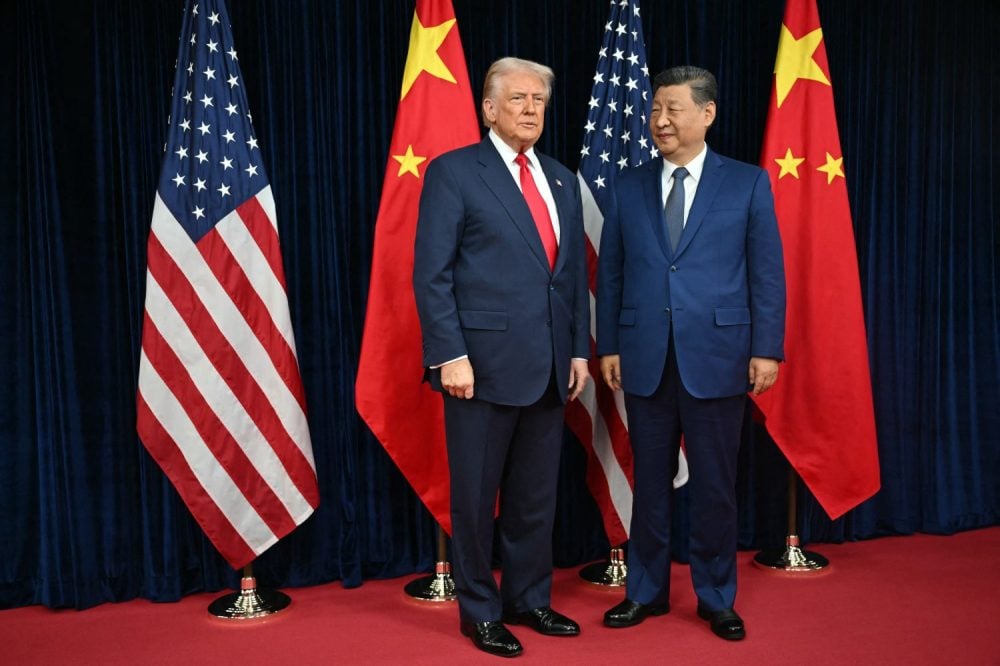Last week’s meeting between Donald Trump and Xi Jinping was the most-anticipated summit between two world leaders this year. The presidents of the United States and China seem to have come away with things they can both describe as wins—and certainly, the two avoided their trade spat getting worse. But according to Elizabeth Economy, a China scholar and former advisor to the Biden administration, the agreement between the two sides was not only limited to just one year but also skirted around the more fundamental structural issues plaguing the relationship.
Economy is now a senior fellow at the Hoover Institution and the author of, most recently, The World According to China. I asked Economy to join me as a guest on FP Live, and we discussed takeaways from the summit, how Beijing is navigating Trump’s second term, and how, on balance, countries in Asia are viewing the biggest superpower showdown this century. Subscribers can watch the full discussion on the video box atop this page. What follows here is a lightly edited and condensed transcript.
Ravi Agrawal: This meeting between Trump and Xi was the most anticipated of the year. The two leaders of the two biggest economies meeting for the first time in six years, with immense consequences for the whole world. There was a wide spectrum of potential outcomes here, from awful to good. What was your big takeaway?
Elizabeth Economy: It ended up on the side of good more than awful. We pretty much knew the outlines of this trade deal because [U.S.] Treasury Secretary Scott Bessent telegraphed the range of small deals that would be struck prior.
It is a great relief to have the two leaders meet, to inject a little bit more stability into the bilateral relationship. But on the other hand, it’s also a little embarrassing for the Trump administration because the outcome of the meeting was that it managed to dig itself out of the hole that it had created when it first launched the trade war eight months ago. It’s great that the two leaders came together to reset the trade table, but it basically took us back to the pre-Trump trade-war status quo, with a few small exceptions around fentanyl and a possible TikTok deal.
RA: On his way back to America, Trump called the meeting a 12 out of 10; Beijing has been more circumspect. How do you read that difference?
EE: It’s always that way, quite frankly, because Trump leans toward the fantastical and big words. He’s done that with virtually all the trade deals—everything is the greatest deal ever. The Chinese, by and large, are much more circumspect. What they had to say reflects the reality of the situation, which is that neither side really got much out of the deal.
RA: There was a lot of talk in the lead-up to the summit that there could be some sort of a grand rapprochement between the United States and China, in part because people say that Trump realizes he should avoid direct conflict with China and instead go for a hedging strategy. For the proponents of that theory, last week’s meeting served as evidence that Trump is now ending the hawkish approach to China that he himself began about a decade ago. Do you buy that theory?
EE: I don’t. I actually see this very differently. The steps Trump is taking at home can weaken the United States when it comes to dealing with China—for example, cutting back on funding for basic research and investment in science and technology. But I don’t think that this means that he is soft on China. The China strategy is basically a byproduct of the “America First” agenda. We’ve taken U.S. leadership on the global stage off the table when it comes to climate change and global health issues; we’re not interested in competing with China for leadership there. We’ve said we don’t have an ideological foreign policy, so we’re no longer in the world of autocracy versus democracy. You don’t hear that language coming out of Trump.
But that doesn’t mean that we’re not competing on technology, or in national security and defense strategy. The president has said he wants to export our technology stack globally; we saw a number of important deals being struck between Japan, South Korea, and the United States around technology and national security during this most recent trip. [U.S.] Secretary [of State] Marco Rubio and [U.S. Defense] Secretary Pete Hegseth have both affirmed the importance of security in the Indo-Pacific on a number of occasions. So, the Trump administration continues to have a highly competitive outlook in these sectors when it comes to China—there hasn’t been any reset in terms of thinking about China as our greatest long-term national security challenge. But when it comes to other areas of soft power, we’ve certainly taken a step back from that traditional role.
RA: Is there more consistency in America’s China policy between the Trump and Biden administrations than some analysts have led on? What are the big differences and what are the throughlines?
EE: The Biden administration’s strategy—which I am intimately familiar with, having worked there for a few years—was “invest, align, compete.” On the invest side, the CHIPS and Science Act is continuing. The Inflation Reduction Act, which was about putting the United States forward in the clean-energy space, has been scaled back. It’s not entirely gone, but it certainly isn’t the top priority for Trump. So, we see some changes there.
But the idea of investing in the United States and bringing back manufacturing (which was a Trump 1.0, a Biden, and a Trump 2.0 priority) is a really important throughline. Both the Biden and Trump administrations may have different ways of trying to achieve these objectives, but the objectives themselves remain the same.
Another big difference is that [former U.S. President Joe] Biden framed the competition with China as autocracy versus democracy. He had three big democracy summits during his four years. That is now off the table. Trump is not interested in a competition between models. He doesn’t tend to differentiate between autocracies and democracies as allies and partners. You can be a friend—a great friend, in fact, as he sometimes refers to Xi—and be the leader of a very repressive political system. And you can be the head of a democracy and face his ire.
Reasserting leadership on the global stage was also very important to the Biden administration: getting back into the Paris climate accords and the United Nations’ Human Rights Council. Trump has pulled us back out of these organizations, but again, that doesn’t mean that he’s not competitive when it comes to things like technology. The president’s efforts to compete in strategic frontier domains—the Arctic, seabed mining, space—have been underreported. These were also important to the Biden administration, but there’s a renewed emphasis emanating from the Trump administration on new forms of investment, which are designed to kickstart the United States in terms of our actual capabilities, like [a deal with Finland to] build four new Arctic ice cutters.
We have to take the time to look not just at what the president says, and what analysts take away from his rhetoric, but at what this administration is doing on the ground. You begin to find more continuity in both administrations in terms of assessing and responding to China. The greater difference is in the approach: The Trump administration tends to be far more coercive with our allies and partners, and the Biden administration tried to be much more oriented toward partnership from the outset.
RA: You’re—quite rightly, I think—advising journalists like me to not focus too much on what Trump says. But one thing that did not come up last week was Taiwan. In light of the key difference you describe between how Biden and Trump organize democracies and autocracies, how important is it that, according to the readouts, Taiwan didn’t come up? What does that mean for Taiwan going forward?
EE: I am sure that the Taiwanese were very relieved, frankly speaking, that Taiwan didn’t come up. It’s rare that Taiwan would not be raised in some form in a meeting with a Chinese leader, that they wouldn’t look to bring some pressure on the United States to affirm the “one China principle” or to try to get the administration to reduce arms sales to Taiwan. But apparently this meeting was very narrowly focused on just the trade relationship.
Trump has said that Xi will not take military action against Taiwan as long as Trump is in office, because Xi knows the consequences. This has morphed into Trump saying that Xi told him he would not take action. I don’t know whether he’s making a mistake in speaking or if it’s just an extension of something that’s not exactly true, because it would be very unusual for Xi to actually commit to Trump that he was not going to take any military action.
In either case, there are structural considerations for this administration that make it difficult for Trump to think about some broader deal that would envelop Taiwan, namely our priority on Indo-Pacific security, because Taiwan is very important for U.S. security. We also have an extraordinary reliance on Taiwan for semiconductors that we need for our defense and technology industries. The president’s work to build back U.S. capabilities in semiconductors isn’t going to be complete by the time he leaves office, so there really isn’t the opportunity, if he were so inclined—and I’m not saying that he is—for a grand bargain involving Taiwan.
RA: The Wall Street Journal published an article recently, titled “China’s New Strategy for Trump: Punch Hard, Concede Little.” In other words, gone is the old Chinese diplomatic playbook. Yes, there will be some concessions on issues that Trump personally cares about—but the real plan, according to this article, is to meet Trump’s tactics with a Chinese version of maximum pressure, as best seen through China’s big step to control rare-earth exports and critical minerals. Do you think China is taking a much tougher approach to Trump in his second term, and if so, is that effective?
EE: They’re certainly taking a tougher approach, but I think they’re taking a tough approach because they can. Part of the problem with the Trump administration, from the outset of the second term, was that they grossly misjudged the degree of leverage that the United States had in the trade space over China. There was an assumption by members of this administration that we have greater leverage because China exports so much more to the United States than the United States does to China. But that ignored the fact that we have a much greater sole source dependency on goods that are critical to our economic and national security, as we’ve seen with rare-earth elements and active pharmaceutical ingredients.
I don’t think there was a lot of preparation done; I think the administration treated China the way it treated all the other countries when it came to launching this massive global trade war. And China signaled, “We are not like any other country, and we actually have more leverage.” Xi has been in office for five more years now than he had been at the outset of the first Trump term. He is more confident: The Chinese economy has grown, and they’re increasingly a dominant player in many sectors, so China’s rise on the global stage is that much further along.
The Chinese took the time to plan out what sort of retaliation they could inflict on the United States. They bolstered their retaliatory toolkit in ways that this administration was unprepared for. I have sympathy for our trade negotiators because they’re trying to negotiate so many deals across the world all at the same time, and they don’t have a good political process in place. So, of course they’re not going to be as well prepared as they should have been.
RA: Where did America go wrong to get to this point where China has such a monopoly in critical minerals? How much of an advantage will that be for China?
EE: It’s important to recognize that China has amassed this rare-earth mining and processing dominance over the course of the past 30 years, in large part because mining and processing rare earths is a horribly dirty and polluting job, and China suffered the environmental consequences of this dominance. It was something that you thought the United States and most other advanced economies had moved past. For 30 years of policy and a relationship premised on engagement and globalization, it didn’t seem as though we were making a big mistake by allowing China to assume this kind of monopoly position. We didn’t have any sense that, at some point, China would use these rare earths in an economically coercive manner until they did it to Japan in 2010 and 2011. That’s the moment where we should have done more to diversify our supply chains and get back in the business ourselves; at the very least, starting to work more on recycling rare earths. Some of our companies do that, so we’re not completely out of the game here.
Nonetheless, we are at a huge disadvantage—both in terms of the light rare-earth elements and the heavy rare-earth developments. Light rare earths are mostly used for clean-energy sectors and electronics, and heavy rare earths are what we need for a lot of our defense industries. We are moving quickly now to strike new deals with other countries like Malaysia and Australia; we’re opening up our own investing. But it’s going to take three to five years for us to regain a semblance of independence in the light rare-earth elements sector and probably another five years after that for heavy rare-earths elements.
Bessent has said we’re going to do this at warp speed, so maybe we can shorten the timeframe a little bit—but it’s going to be well beyond the one-year suspension that the Chinese have put in place with this trade deal. A really important point to remember about this deal is that many parts of it are only good for a year.
The Chinese didn’t just launch this rare-earth element competition against the United States. They launched it globally and produced a firestorm. And I don’t think they were even ready to think about how they were going to implement it. They’ve said they’re going to refine and study this rare-earth element export control process; they have not said that it’s completely off the table forever. So, we are going to have to work very quickly, because a year from now they’re going to have some export controls on the heavy rare-earth elements that are going to be targeted against our defense industries.
RA: Beyond the things that came up last week, there are a lot of fundamental, structural issues in the relationship that didn’t come up: industrial subsidies, market access barriers, cyber espionage. Talk a bit about the scale of all those issues. What would it take to be in a place to bring those issues up?
EE: The Chinese economy is exporting all this overcapacity, dominating the world in the clean-energy space with electric vehicles, lithium batteries, solar panels, and wind turbines. And we’re going to see this happen in sector after sector. When you look at the “Made in China 2025” platform of 10 critical cutting-edge technologies, whether it’s new materials, AI, or semiconductors, this is the playbook that China has put in place.
Unless we take action to get at the fundamental nature of the Chinese model, the United States and the world are going to be swamped by Chinese technology across a whole array of sectors. The only way that the United States can actually deal with the structural impediments in the Chinese economy is by working not only with our traditional allies and partners, but also with emerging and middle-income economies, to bring pressure to bear on China.
We’ve seen, at least in the EV space, that it was not simply the United States, Europe, Japan, and South Korea that refused to take all the Chinese EVs. A whole new set of countries—Brazil, India, and Turkey—stepped forward, saying we can’t have our nascent industries killed before they even have a chance to grow. So, I think there is a play here that the United States could make, but it would require us to do what this administration typically doesn’t do that well, which is to reach out and bring allies and partners together in a concentrated way.
One caveat I should add is that the Chinese are interested in greater market access in the United States. We’ve spent the past four to six years becoming much more concerned about Chinese investment in the United States; it’s basically fallen off a cliff. So if we were willing to open more access for Chinese investment in the United States, we might get some reciprocity on the Chinese side. But in no way would it be enough to compensate for the wave of what we’re about to experience coming out of China.
RA: Another key difference between the second Trump administration and the Biden administration across the board is that the United States has backed off from its secret sauce—its alliances. How is that changing how countries in the global south view U.S.-China competition and America’s ceding of geopolitical space? Are countries beginning to turn to China more?
EE: We’ve seen many polls coming from emerging and middle-income economies that there’s been a precipitous fall in the level of U.S. attractiveness to many countries since the Trump administration came into office. The decision to envelop the U.S. Agency for International Development (USAID) into the State Department in a much more diminished capacity has had widespread ramifications, as have pulling out of the Paris Agreement and the World Health Organization—areas where the United States has traditionally been a generous leader and earned goodwill from people across the world.
That doesn’t mean that other countries don’t want to continue partnering and working with the United States. China has its own issues: Overcapacity is an issue, and the Belt and Road Initiative has many problems associated with it for emerging and middle-income economies. Not that many countries really love China’s political system. So it’s not as though China in and of itself is that attractive a pull for other countries to attach themselves to, as opposed to the United States. Nonetheless, we’ve definitely given China a big opening.
The past week has shown me that we haven’t taken ourselves completely out of the game and that there’s still space for us to recover and recoup. I’ve been very encouraged by the technology prosperity agreements that we’ve signed with the United Kingdom, Japan, and South Korea. I think these are coming out of Science Advisor Michael Kratsios, who is the uber czar for technology. I’m also reassured by Hegseth’s discussions about affirming our security commitment in the Indo-Pacific. Maybe after roiling the international system and attacking our allies and partners for the first nine months, we’re coming back to rebuilding some of these relationships.
In general, countries in the Indo-Pacific are more sanguine about the Trump administration than our European allies. The South Korean president gifted Trump a massive gold crown and a medal—could there be anything more appealing to him than that? They have an understanding of Trump and a willingness to deal with him, and to some extent, the Europeans don’t want to do that. So I’m a little more optimistic after this week.
RA: We love optimism on this show, so I thank you for that.
We’ve talked a fair bit about the United States ceding space in certain areas. What is your sense of how China thinks about voids and vacuums in different global arenas? Does it want to jump into areas it sees as vacuums, or does it want to leave these areas as voids and just not be responsible?
EE: I often think of China as wanting to have the rights of a global superpower without the responsibilities. China wants the time and space to fill the void as it sees fit. When it comes to USAID, for example, and the tens of billions of dollars that the United States has provided to the world in terms of overseas development assistance, China is not filling that void. It has taken a few steps in a few areas—it walked into Cambodia and picked up millions in project that the United States used to have—but it’s not going to replace the United States, and it has no interest in doing so. That’s not its model.
China can win in spaces like the World Health Organization or global climate change simply by doing what it’s doing. If we’ve taken ourselves out of the game—if we’ve taken our marbles and simply gone home—China doesn’t have to up its game to be a leader. China is going to pick and choose where it wants to fill the void, and to the extent it can fill the void simply by reinforcing the fact that the United States is no longer doing what it used to do, I think it will do so.
The post How Beijing Views Trump appeared first on Foreign Policy.




